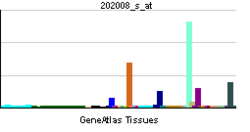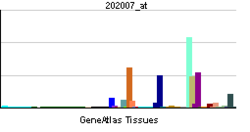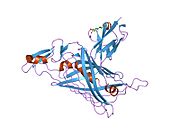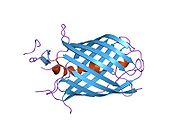- Entactin
-
Nidogen 1 
PDB rendering based on 1gl4.Available structures PDB 1gl4, 1h4u Identifiers Symbols NID1; NID External IDs OMIM: 131390 MGI: 97342 HomoloGene: 1878 GeneCards: NID1 Gene Gene Ontology Molecular function • calcium ion binding Cellular component • extracellular region
• basement membrane
• extracellular matrixBiological process • cell adhesion
• cell-matrix adhesionSources: Amigo / QuickGO RNA expression pattern 

More reference expression data Orthologs Species Human Mouse Entrez 4811 18073 Ensembl ENSG00000116962 ENSMUSG00000005397 UniProt P14543 P10493 RefSeq (mRNA) NM_002508.2 NM_010917.2 RefSeq (protein) NP_002499.2 NP_035047.2 Location (UCSC) Chr 1:
236.14 – 236.23 MbChr 13:
13.53 – 13.6 MbPubMed search [1] [2] Entactin also known as nidogen-1 (NID-1) is a protein that in humans is encoded by the NID1 gene.[1][2] Entactin is a component of the basement membrane alongside other components such as collagen type IV, proteoglycans (heparan sulfate and glycosaminoglycans), laminin[3] and fibronectin[4].
Contents
Function
Entactin is a member of the nidogen family of basement membrane glycoproteins. The protein interacts with several other components of basement membranes. Structurally it (along with perlecan) connects the networks formed by collagens and laminins to each other.[5] It may also play a role in cell interactions with the extracellular matrix.[6]
Interactions
Entactin has been shown to interact with FBLN1.[7][8][9]
References
- ^ Olsen DR, Nagayoshi T, Fazio M, Mattei MG, Passage E, Weil D, Timpl R, Chu ML, Uitto J (June 1989). "Human nidogen: cDNA cloning, cellular expression, and mapping of the gene to chromosome Iq43". Am. J. Hum. Genet. 44 (6): 876–85. PMC 1715653. PMID 2471408. http://www.pubmedcentral.nih.gov/articlerender.fcgi?tool=pmcentrez&artid=1715653.
- ^ Zimmermann K, Hoischen S, Hafner M, Nischt R (May 1995). "Genomic sequences and structural organization of the human nidogen gene (NID)". Genomics 27 (2): 245–50. doi:10.1006/geno.1995.1038. PMID 7557988.
- ^ Smith J, Ockleford CD (January 1994). "Laser scanning confocal examination and comparison of nidogen (entactin) with laminin in term human amniochorion". Placenta 15 (1): 95–106. doi:10.1016/S0143-4004(05)80240-1. PMID 8208674.
- ^ Ockleford CD, Bright N, Hubbard A, D'Lacey C , Smith J, Gardiner L, Sheikh T, Albentosa, M, Turtle K (October 1993). "Micro-Trabeculae, Macro-Plaques or Mini-Basement Membranes in Human Term Fetal Membranes?". Phil. Trans. R. Soc. Lond. B 342 (1300): 121–136. doi:10.1098/rstb.1993.0142. http://rstb.royalsocietypublishing.org/content/342/1300/121.short.
- ^ Yurchenco, P.D., Patton, B.L. (2009). "Developmental and pathogenic mechanisms of basement membrane assembly". Current Pharmaceutical Design 15: 1277–1294.
- ^ "Entrez Gene: NID1 nidogen 1". http://www.ncbi.nlm.nih.gov/sites/entrez?Db=gene&Cmd=ShowDetailView&TermToSearch=4811.
- ^ Adam S, Göhring W, Wiedemann H, Chu ML, Timpl R, Kostka G (September 1997). "Binding of fibulin-1 to nidogen depends on its C-terminal globular domain and a specific array of calcium-binding epidermal growth factor-like (EG) modules". J. Mol. Biol. 272 (2): 226–36. doi:10.1006/jmbi.1997.1244. PMID 9299350.
- ^ Tran H, VanDusen WJ, Argraves WS (September 1997). "The self-association and fibronectin-binding sites of fibulin-1 map to calcium-binding epidermal growth factor-like domains". J. Biol. Chem. 272 (36): 22600–6. doi:10.1074/jbc.272.36.22600. PMID 9278415.
- ^ Pan TC, Kluge M, Zhang RZ, Mayer U, Timpl R, Chu ML (August 1993). "Sequence of extracellular mouse protein BM-90/fibulin and its calcium-dependent binding to other basement-membrane ligands". Eur. J. Biochem. 215 (3): 733–40. doi:10.1111/j.1432-1033.1993.tb18086.x. PMID 8354280.
Further reading
PDB gallery External links
Categories:- Human proteins
- Chromosome 1 gene stubs
- Histology
- Glycoproteins
Wikimedia Foundation. 2010.


